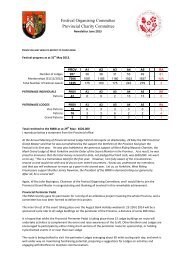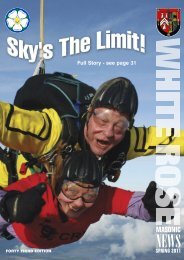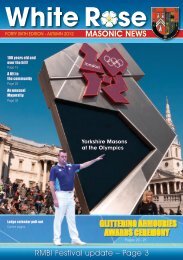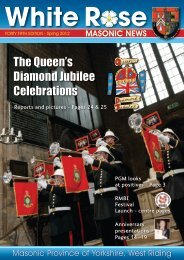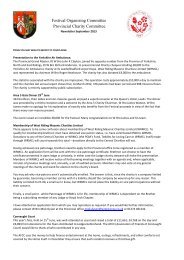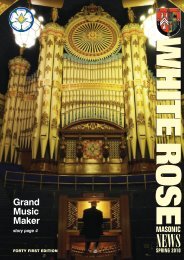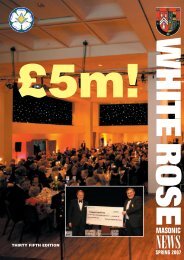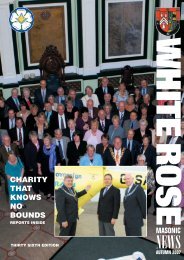white_rose_newsletter_42-1 - Masonic Province of Yorkshire, West ...
white_rose_newsletter_42-1 - Masonic Province of Yorkshire, West ...
white_rose_newsletter_42-1 - Masonic Province of Yorkshire, West ...
Create successful ePaper yourself
Turn your PDF publications into a flip-book with our unique Google optimized e-Paper software.
FIRING AND FIRING GLASSESBy W Bro Rod G Taylor, <strong>of</strong> Lightcliffe LodgeNo 3332 - an avid collectorI COLLECT antique drinkingglasses, particularly firingglasses, and this articledescribes them, and thetoasting rituals thataccompanied their use.In the late 17th and the18th century, toasts wereaccompanied by the beating<strong>of</strong> drums, a fanfare <strong>of</strong> music,or other gestures <strong>of</strong>celebration. This is where theterm “firing” came from,because it originally meant“gunfire”. All sorts <strong>of</strong> firearmswere used, from muskets tocannon procured speciallyfor the purpose. Firing is anaudiovisual exclamationmark, done to endorse andreinforce a toast.Figure 1.A firing glass decorated with crypticJacobite symbolsBut the discharging <strong>of</strong> firearms to celebrate a toast had itsdrawbacks – the smoke, holes in the ceiling, inadvertentlymurdering one’s host - and a safer alternative emerged in the use<strong>of</strong> the firing glass, banged on the table to imitate the sound <strong>of</strong>gunfire. Among Freemasons, the verbal imagery relating firingglasses to guns was first described in French exposuresmaterial came in the form <strong>of</strong>the heavy, lead glassdeveloped around 1674.The firing glass is short andstumpy, with a small bowl,because the drinker has toempty it before he bangs iton the table. The bowl is seton a thick stem, or directlyon the foot, which is muchthicker than that <strong>of</strong> anordinary glass, and may beflanged or terraced.<strong>Masonic</strong> engraving onglasses became commonafter 1760, and someglasses were so stronglyassociated with the Craftthat they were known simplyFigure 3. Firing glass engraved with squareand compasses, and number <strong>of</strong> Lodgeas “Right Free-Masons”. The commonest decoration is thesquare and compasses, <strong>of</strong>ten with the name or number <strong>of</strong> theLodge, followed by the sun and the moon, or the jewels <strong>of</strong> theMaster or his Wardens.We now use the term “firing” to describe the “Point, left, right”hand movements and synchronised clapping which precede thebanging down <strong>of</strong> the glass. These derive from early modes <strong>of</strong>recognition, from military terms, and from rhythmic clapping usedby all sorts <strong>of</strong> people, not just Masons. The expression “firing”probably came to be applied to them as firing glasses fell out <strong>of</strong>use.Firing is done throughout <strong>Yorkshire</strong> North and East Ridings, butis rare in our <strong>Province</strong>. The reason for this is not clear. I havefound some evidence that firing was previously more widespreadin the <strong>West</strong> Riding.The author <strong>of</strong> a French exposure <strong>of</strong> 1744 says “I could notattempt to describe the singular pleasure which the Free-Masonsderive from this manner <strong>of</strong> toasting; they alone feel it & they couldnot describe it themselves”.TO place an advertisement in White Rose,please contact any <strong>of</strong> the following:Marketing and Advertising ChairmanFigure 2. Two late 18th century dram glasses: ordinary glass on the left, firingglass on the rightpublished from 1737 onwards. From Le Secret Des Francs-Maçons, 1744: “All the terms they use…are borrowed from theArtillery. The bottle is called Barrel… wine is called red Powder…they use only goblets, which they call Cannon…”The firing glass may have originated from the thumping glass,a tumbler with a thick, solid base, used in the late 17th century, orfrom the ship’s glass, which had a thick, broad foot to keep itupright. Firing glasses probably first came in around 1720, andthey were also used by non-<strong>Masonic</strong> clubs and societies, such asthe Jacobites (figure 1) and the wonderfully-named SublimeSociety <strong>of</strong> Beefsteaks.Any glass that is to be banged on the table to imitate the sound<strong>of</strong> gunfire must be strong enough to stand the task. The rightStuart Cadman stuart.cadman@wrprovince.co.ukTelephone: 01274 873<strong>42</strong>6 M: 07710 451873Advertising team membersJohn Watson john.watson@wrprovince.co.ukTelephone: 01132 893905Martin Charlesworth martin.charlesworth@wrprovince.co.ukTelephone: 07783 687313Paul Shipley paul.shipley@wrprovince.co.ukTelephone: 01132 283215Keith Grandison keith.grandison@wrprovince.co.ukTelephone: 01943 864612David Hayes david.hayes@wrprovince.co.ukTelephone: 011<strong>42</strong> 763633Adrian Collins Adrian.collins@wrprovince.co.ukTelephone: 07912 669505LODGE ACACIA No.2321 IS PROUD TO SUPPORT THIS PAGE OF THE WHITE ROSE MASONIC NEWS.Meeting on the 4th Thursday <strong>of</strong> every month except August at <strong>Masonic</strong> Hall, Hoyle Court Baildon, Shipley. BD17 6JS21




